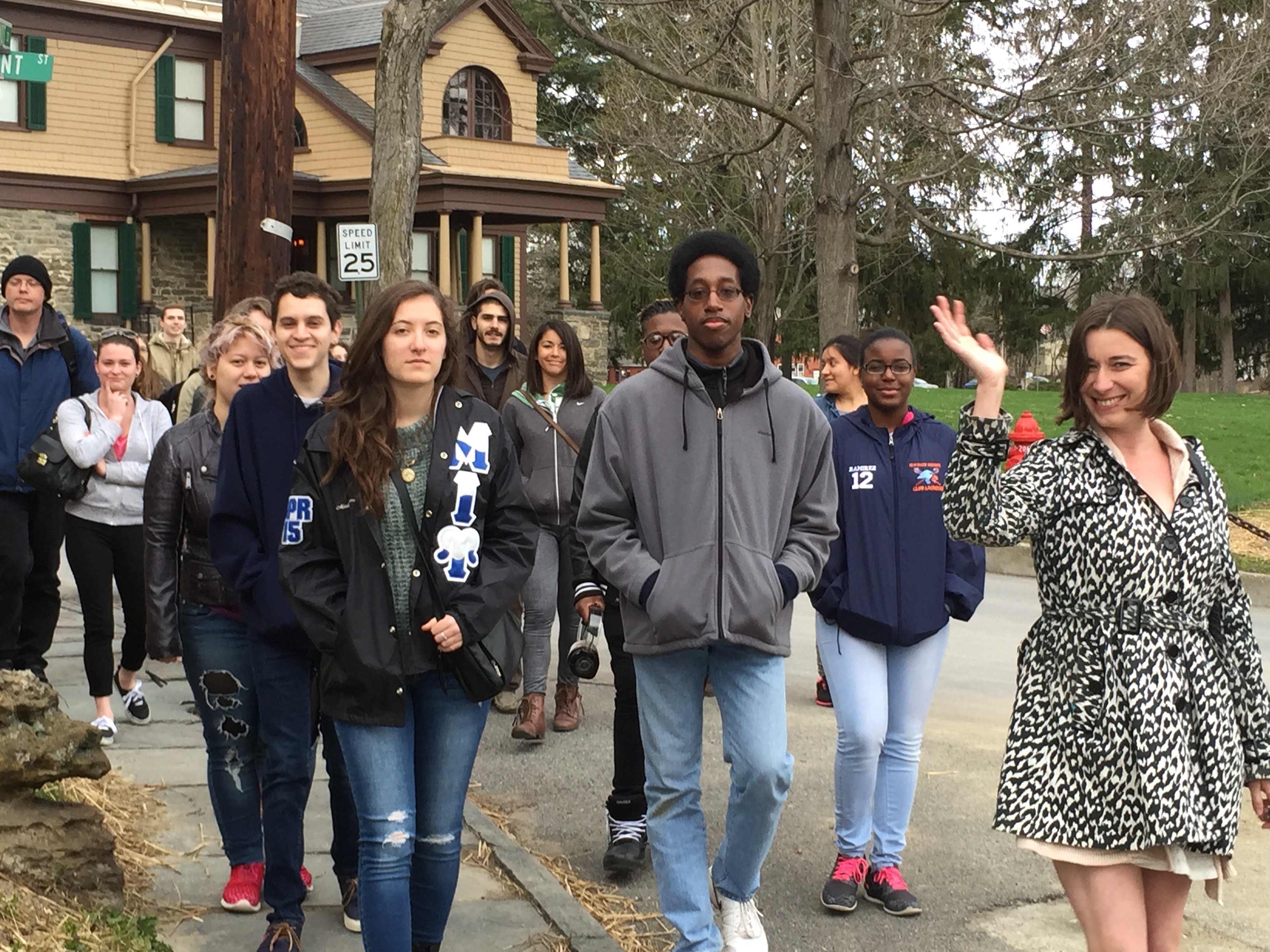
Call it whatever you like: farm team, bench, pipeline
One thing broadcast radio has sorely missed as an industry is a focus on youth. Looking back on the last several decades, I’ve come to believe radio’s not-so-benign neglect of teens can be traced back to advertisers foisting their 25-54 goals on radio sellers. From there, the trickle down theory took root. When appealing to those under 25 becomes financially unviable, so does connecting with young generations of listeners – and workers.
At one time, they were thought of as teens and college students. Today, they have a brand – Gen Z.
And they have numbers – now roughly 20% of the entire U.S. population. They are in growth mode, and they are the most diverse generation in American history. Born between 1997 and 2012, many Gen Zers still listen to broadcast radio, but other options are more popular, accessible, and more targeted to their tastes and sensibilities.
After all, why would FM radio be much of a consideration when the vast majority of stations today fail to include Gen Z in their research, planning, programming, or outreach? This is especially the case with commercial radio music and spoken word stations, but also in the Christian and public radio world where both listening and donations are welcome. But for radio properties that depend on cash contributions from the audience, a “youth movement” is more a long-term investment because the Z generation isn’t usually flush with cash, having their futures rocked by the Great Recession when they were very young, right up to the ravages of the pandemic in recent years.
For radio broadcasters to make a strategic effort to even consider a teen strategy has been a bridge too far for most companies. While many have generously supported efforts like Dan Vallie’s institutes or awards programs run by many state broadcaster associations, the proof of their commitment – actual HD1 radio stations targeted to Gen Z’s have not happened with any consistency, much less sustainability. It is the big can always kicked down the road. Radio broadcasters just can’t see their way clear to recognizing the problem – or the opportunity – and committing serious efforts or dollars to launching viable content offerings aimed at Z’s.
Readers of JacoBLOG know this is one of my true passion issues with our industry that has evolved into a pain point. If there is anything strategic about how radio companies truly plan for their uncertain futures, developing a serious youth marketing initiative would be something they should launch this year. Or last week. All the research and data indicate this generation of young Americans isn’t just large – they’re different, impacted by the world around them these past couple decades.
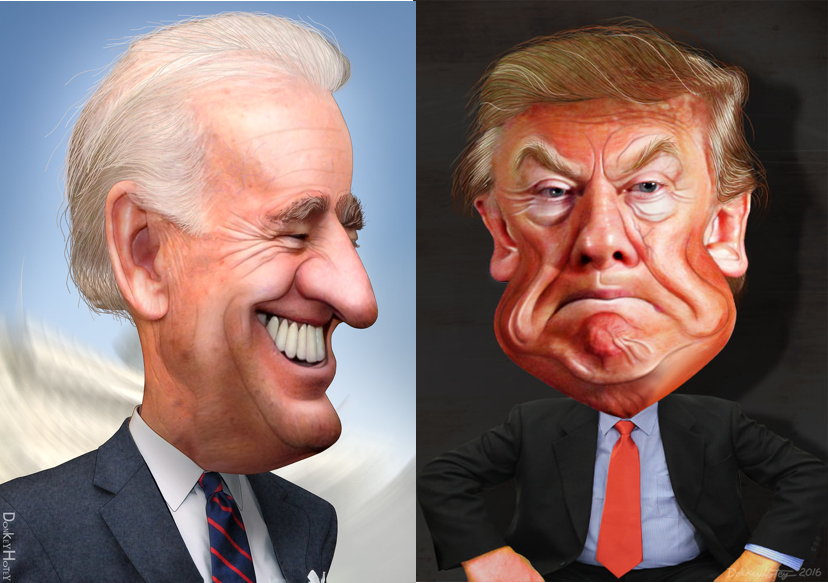 Climate change, the political abyss, student loan debt, and social justice issues are all swirling around them. And then there’s our “Ground Hog Day” presidential election this year where the same two geezers, old enough to be their (great) grandfathers are apparently the best Americans can do to solve its problems and forge deeper into another disappointing decade in this 21st century.
Climate change, the political abyss, student loan debt, and social justice issues are all swirling around them. And then there’s our “Ground Hog Day” presidential election this year where the same two geezers, old enough to be their (great) grandfathers are apparently the best Americans can do to solve its problems and forge deeper into another disappointing decade in this 21st century.
Against that backdrop, most radio broadcasters have simply kept their heads down, preferring instead to watch the average age of their audience drift into 50+ range and even older. A junior high student could tell you that for an industry flailing to remain relevant, excluding Gen Z isn’t just a bad idea – it’s a guarantee of obsolescence. The seemingly nonending waves of layoffs and pending bankruptcies and hostile takeovers are just the beginning of a self-fulfilling prophecy to age out and become a nostalgic remanent of some of our pasts.
But despite the dour forecasts for growth and profitability comes a couple broadcasters willing to see their world differently, each from different corners of the radio universe: Christian music and commercial radio News/Talk, two very different ends of the broadcast spectrum each acknowledging that a quantum change has to come – and as Lee Abrams might implore them: ACFDI.
First, it’s the Christian Music Broadcasters, an organization run by a 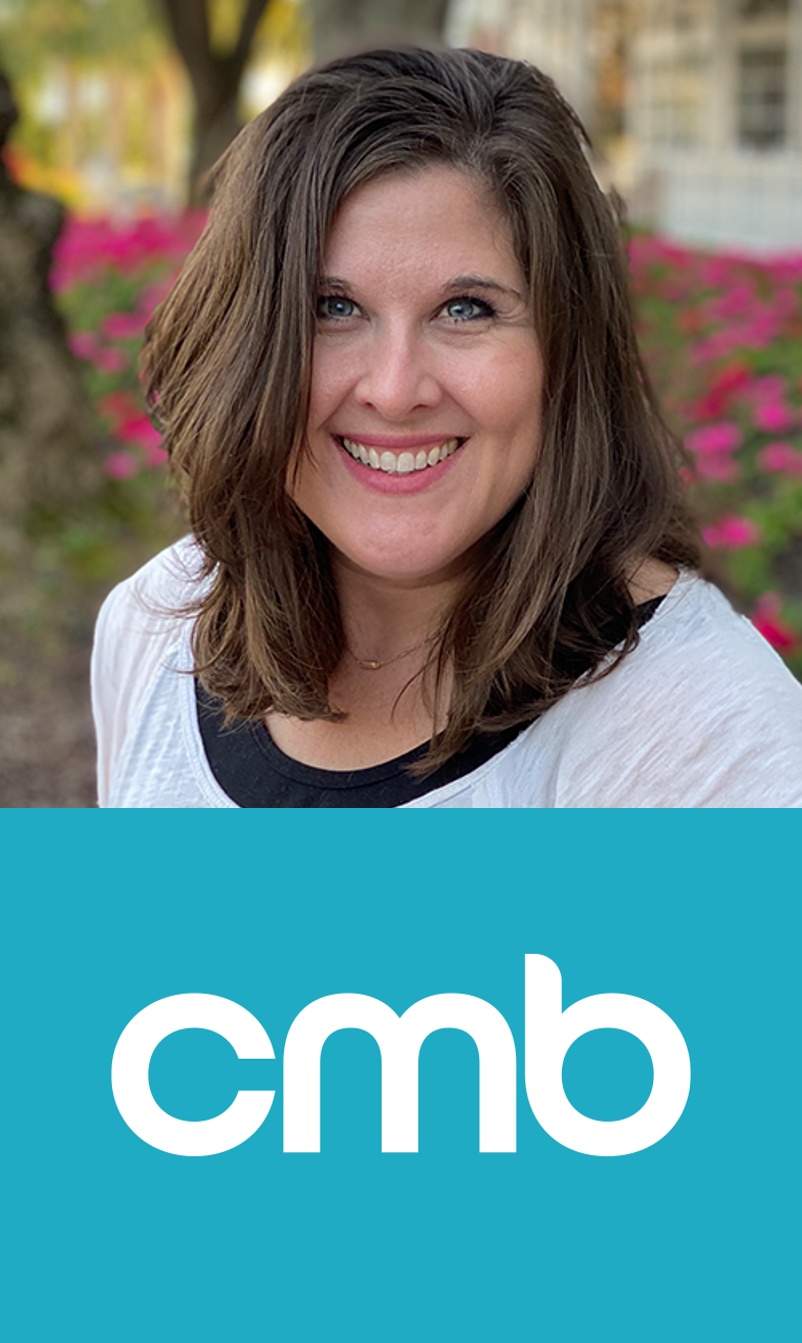 radio visionary and hardcore fan, Michelle Younkman. Her Momentum events are brilliantly put together, produced, and seamlessly run. If you’ve been to one – or presented there, as we have on several occasions – you know these gatherings are world class. Michelle is a champion for her stations, the format, and the mission.
radio visionary and hardcore fan, Michelle Younkman. Her Momentum events are brilliantly put together, produced, and seamlessly run. If you’ve been to one – or presented there, as we have on several occasions – you know these gatherings are world class. Michelle is a champion for her stations, the format, and the mission.
More than a decade ago, she was concerned about ensuring her members had sufficient research and data from which to make intelligent decisions. And that’s when CMB and Jacobs Media (yup, Tim Davis) partnered together on our first Christian music version of Techsurvey.
A decade later, we have data – lots of it – that tell an important story about how Michelle’s membership can navigate their way through changing times and cultural sensibilities during a time of spiritual reawakening for so many people. In the CMB version of Techsurvey, we don’t just inquire about apps, smart speakers, and “connected cars.” There are many questions related to faith and spirituality. That’s these radio stations’ “why’s.”
Our samples are loaded with CMB member stations as well as networks like K-LOVE and Air1 – all eager to learn more about their audiences than they can from Nielsen monthlies. It should come as no surprise why core listeners to Christian music radio spend very little time with “secular” radio. It mostly fails to speak to their needs and their beliefs.
The proof of the viability of the format is in their Net Promoter recommendation scores. Year after year, they lead the rest of the “radio league” in this valuable measure of loyalty. And their margin of victory is growing, opening a gap over both public and commercial radio.
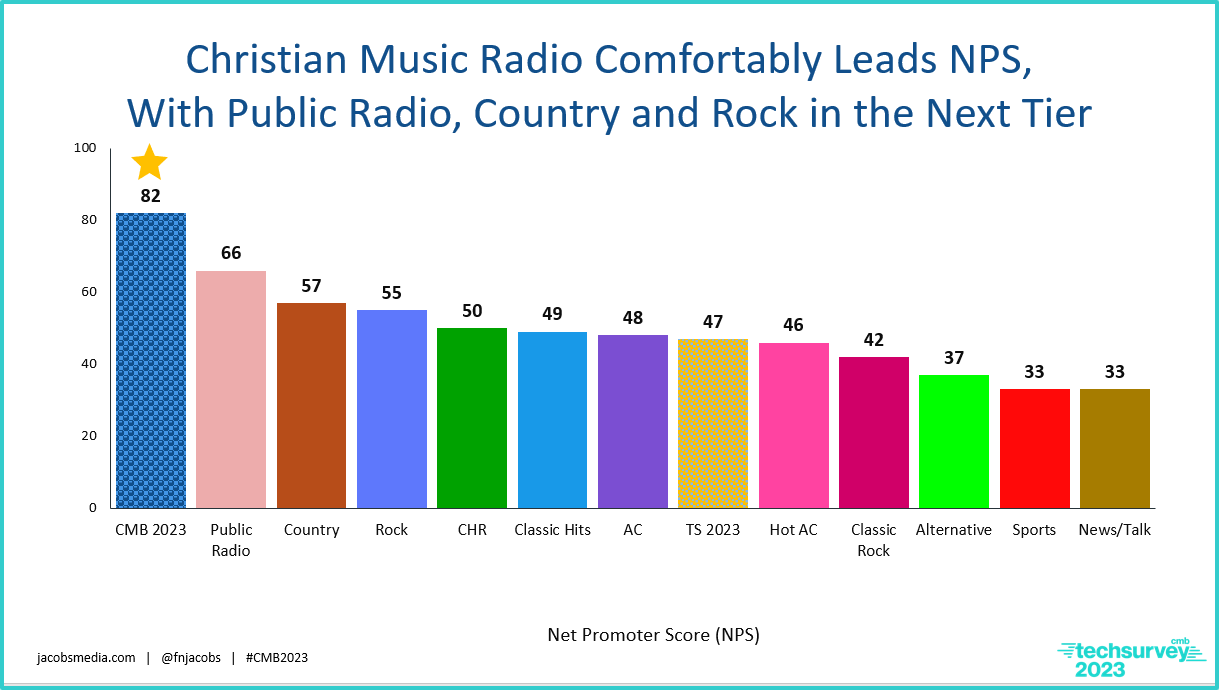
All that said, Michelle realizes not enough is known about younger generations of Americans. While they listen to her member stations, the demographic and strategic limitations facing the entire radio broadcasting industry manifest themselves in her organization, too.
So, she’s doing something about it. Next week, Paul and I will join her elite Gold Member group to present a fascinating look at Christian music fans – by generation. And yes, that includes actually talking to Gen Z’s, learning who they are, where they’re different, and when they profile like everybody else listening to these stations. We even recruited a near-Gen Z moderator, Allie Jacobs, to moderate our Gen Z group rather than her aging father and uncle.
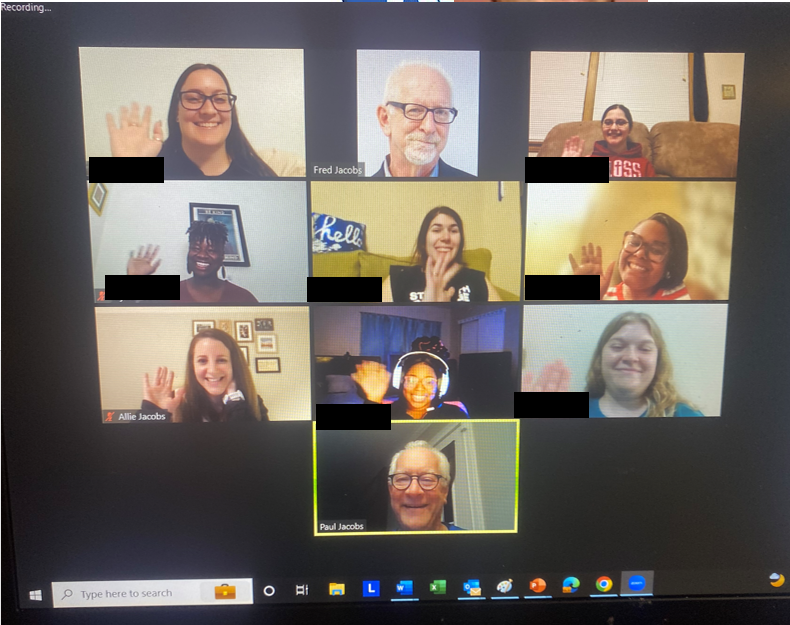
Yes, it’s focus groups – but it’s a start. In fact, over the last 40 years, the only other times we’ve been asked what teens think was when we worked for MTV in the ’80s and later for Electronic Arts in the ’90s when they needed to see how teens reacted to the soundtracks of their world famous video games. A radio company has never asked us to recruit teens – ever.
Segue to Pittsburgh, and Audacy’s KDKA Radio, widely considered to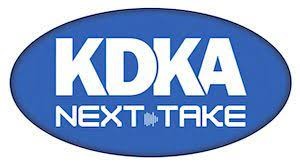 be the nation’s first commercial station, debuting on election day in 1920. Fittingly, a breakthrough new show hosted by college students from the University of Pittsburgh has debuted. “KDKA Next Take” is designed to “redefine radio and will provide news, information and talk from a different point of view, (radio) overnights.”
be the nation’s first commercial station, debuting on election day in 1920. Fittingly, a breakthrough new show hosted by college students from the University of Pittsburgh has debuted. “KDKA Next Take” is designed to “redefine radio and will provide news, information and talk from a different point of view, (radio) overnights.”
I added “radio” in parentheses to KDKA’s pronouncement because the source of this bold new show is, in fact, what the headline ought to be. The fact a show created by and targeted to Gen Z’s is being produced by a local commercial radio station is the story.
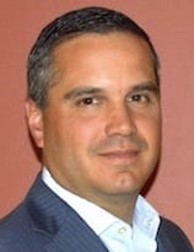 Axios reporter Erica Paney recently wrote a deep dive on Gen Z. It’s brief, but meaty, and I urge you to read it, because it outlines the thinking of Michelle Younkman and KDKA SVP/market manager, Michael Spacciapolli (pictured) whose comment on “Next Take” tells you precisely where he’s coming from:
Axios reporter Erica Paney recently wrote a deep dive on Gen Z. It’s brief, but meaty, and I urge you to read it, because it outlines the thinking of Michelle Younkman and KDKA SVP/market manager, Michael Spacciapolli (pictured) whose comment on “Next Take” tells you precisely where he’s coming from:
“This is a project that I have been developing for a few years and it’s ready to launch. It’s the right time and the right place with the right people. This show will bring a fresh look at local news from the perspective of the next generation, which is so crucial in 2024 and beyond.”
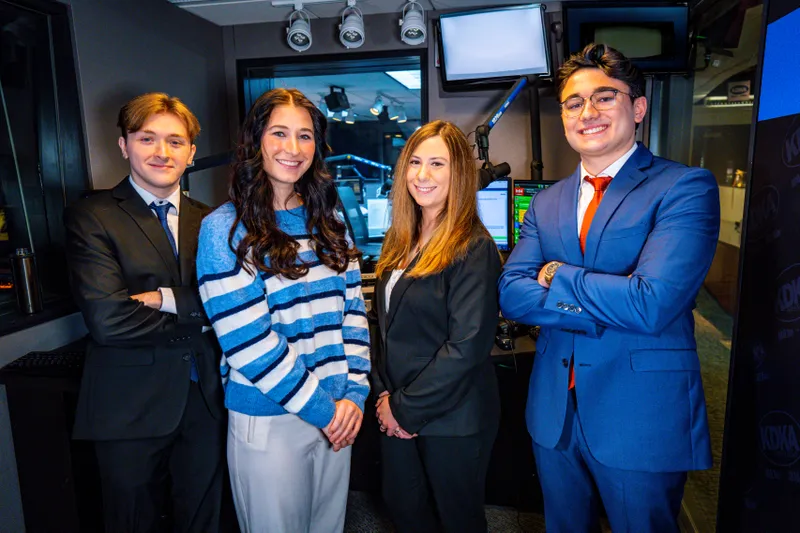
Speaking of “the right people,” the new show on KDKA is staffed by Pitt students Margaux Rentzel, Jaime Ely, and Ryan Tarabokia, and produced by Dylan Foster. The executive producer is KDKA vet Amy Mauk.
As Axios reporter Erica Pandy reminds us, most Gen Z’s get their “news” now by simply being plugged into Instagram and TikTok. As Stephanie Kaplan Lewis, CEO of Her Campus Media, explains:
“Gen Z is being fed the news (from social media) whether they want it or not.” And she adds that young people are less likely than Millennials to navigate to trusted news sources directly.
Against that backdrop comes a legendary commercial radio station in Pittsburgh trying to make history…again.
What will be the “hit” to the bottom line Spacciopolli may suffer due to losses incurred by “Next Take?” It’s a rounding error, and will be much less costly to KDKA if they don’t wean themselves off of aging Boomers and the diminishing ranks of the geriatric Greatest Generation.
These energetic Gen Z’s from Pitt are breaking ground, and will no doubt learn a lot from their “real world” radio experience. But I’m betting the storied KDKA staff will learn even more about the rapidly changing sands of journalism, news gathering, and media consumption.
And they’d better. Radio’s entire future depends on it.
- What To Do If Your Radio Station Goes Through A Midlife Crisis - April 25, 2025
- A 2020 Lesson?It Could All Be Gone In A Flash - April 24, 2025
- How AI Can Give Radio Personalities More…PERSONALITY - April 23, 2025




Pittsburgh as a culture has enough problems getting out of its own aging way. Honorable mention to WYEP, while I find the delivery too corporate and unrelatable, they have made a few local and young music careers, and compensate visual artists for their work for their events. I hope though that people in my age range don’t have such an arrogant sandbox mentality. My advice? Yinz have fun annat DaunTaunb at Foster Plaza.
Radio is aging everywhere, a reality that shouldn’t be lost on any of us working in the business.
Great move by KDKA. Looking back at the time, HD should have been the Great Farm Team for students and new competitive formats. How many cars are equipped with HD today? A demonstrator at an NAB once told me, “Nice sound….too bad there’s nothing to listen to.”
Fred has rightly advocated this for years. Corporate radio leadership is mostly “asleep at the switch”–while the train is headed for the cliff as the audience ages out. If they don’t wake up it’s not going to be pretty.
clark, it didn’t have to be that way. But broadcasters simply weren’t serious about doing a whole lot bold or innovative in the early 2000s. And it has cost the industry dearly.
Welcome news from KDKA in combination with another encouraging release about radio appealing to Gen Z: BEA announced their winners of best in college media from over 1,800 submissions from more than 300 schools. As someone who spent a significant amount of time and energy helping revitalize student broadcasting at a university, I love to see that radio is not dead to Gen Z. In fact, where I currently hang my hat (Penn State), there are two thriving “college radio” opportunities, WKPS and the streaming Comms Radio, plus internship opportunities that get filled every semester at WPSU, the NPR affiliate. If the interest of college students in still staffing radio stations is any indicator, the kids are alright.
Frank, thanks for this, and the heads-up about BEA and Penn State. I am all about giving out awards to students for work well done and to college (and high school) radio for maintanning good-sounding stations. But it is parwamount radio broadcasters to what KDKA is doing: clear out a dead daypart llike overnights and give these high-achieving students an opporutnity to be on the air and learn from professional broadcasters (and vice-versa).
Amen! I couldn’t agree more!
Thank you, Frank!
This response (especially the last paragraph) in a recent interview with the head of Grupo Renascença Multimédia’s radio division (at https://www.redtech.pro/grupo-renascenca-multimedia-responds-to-tech-and-audience-shifts) really jumped out at me…
“Younger listeners are critical for Renascença’s long-term viability, so we create content tailored to their interests. Developing a radio habit among younger listeners demands not just on-air methods but a strong online and social media presence.
“Simultaneously, younger listeners teach us a lot about where media is heading. They demand new information, entertainment, music and talent models, all within a peer-to-peer recommendation environment.
“They move fast and don’t look back, and we must move with them — be at their parties, help them find new music and introduce them to personalities, on all platforms, around the clock.
“That’s what we do with Mega Hits. It is a talent nursery for all the other stations, our lab for procedures and systems and an innovation accelerator.”
(Mega Hits is the group’s CHR, with possibly a Rhythmic lean. Its sisters are RFM [Hot AC or perhaps Adult CHR] and Rádio Renascença [“generalist”/full-service AC, likely Gold-based].)
Eric, the whole thing is brilliant, prescient, and so missing here in the U.S. Portugal, eh? Thanks so much for sharing this.
Good info, thank you.
You’re welcome. Thanks for reading it.